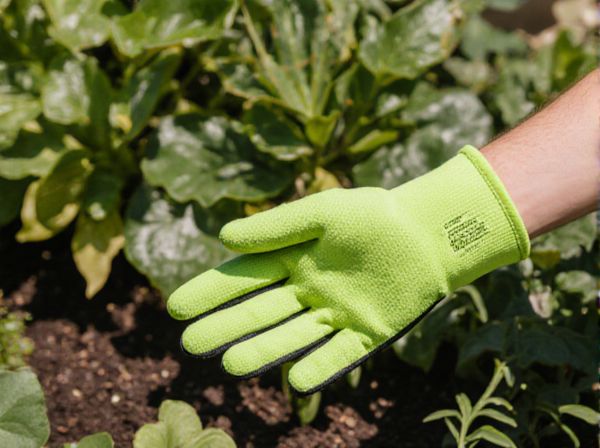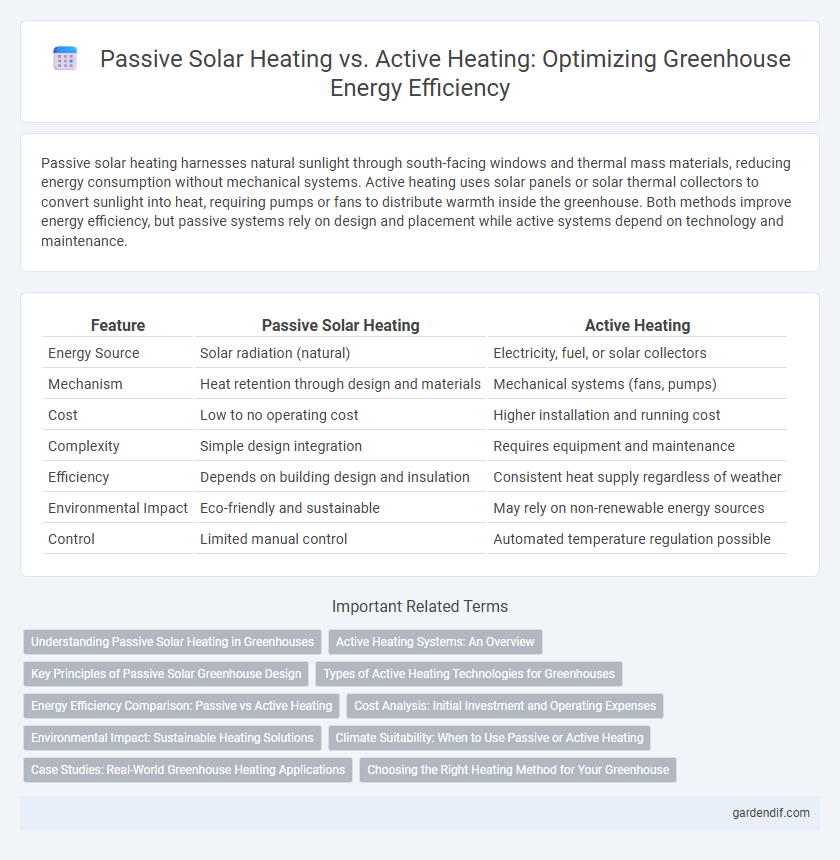
Passive Solar Heating vs Active Heating Illustration
Passive solar heating harnesses natural sunlight through south-facing windows and thermal mass materials, reducing energy consumption without mechanical systems. Active heating uses solar panels or solar thermal collectors to convert sunlight into heat, requiring pumps or fans to distribute warmth inside the greenhouse. Both methods improve energy efficiency, but passive systems rely on design and placement while active systems depend on technology and maintenance.
Table of Comparison
| Feature | Passive Solar Heating | Active Heating |
|---|---|---|
| Energy Source | Solar radiation (natural) | Electricity, fuel, or solar collectors |
| Mechanism | Heat retention through design and materials | Mechanical systems (fans, pumps) |
| Cost | Low to no operating cost | Higher installation and running cost |
| Complexity | Simple design integration | Requires equipment and maintenance |
| Efficiency | Depends on building design and insulation | Consistent heat supply regardless of weather |
| Environmental Impact | Eco-friendly and sustainable | May rely on non-renewable energy sources |
| Control | Limited manual control | Automated temperature regulation possible |
Understanding Passive Solar Heating in Greenhouses
Passive solar heating in greenhouses relies on the strategic use of materials and design to capture and store solar energy without mechanical systems. Thermal mass components such as concrete floors, water barrels, or stone walls absorb sunlight during the day and release heat gradually, maintaining a stable internal temperature. This energy-efficient method reduces reliance on external power sources and lowers heating costs in controlled agricultural environments.
Active Heating Systems: An Overview
Active heating systems in greenhouses utilize mechanical methods such as electric heaters, gas furnaces, and forced-air systems to maintain optimal temperatures. These systems offer precise temperature control by circulating warm air or water through pipes, ensuring consistent heat distribution regardless of external weather conditions. Combining thermostats and sensors enhances energy efficiency and supports plant growth during colder periods.
Key Principles of Passive Solar Greenhouse Design
Passive solar heating in greenhouses relies on design elements like orientation, thermal mass, and insulation to capture and store solar energy without mechanical systems. Key principles include maximizing southern exposure, using materials such as concrete or water barrels to absorb heat during the day, and insulating north walls to reduce heat loss. This method reduces energy costs and maintains stable indoor temperatures by harnessing natural sunlight effectively.
Types of Active Heating Technologies for Greenhouses
Active heating technologies for greenhouses include forced-air systems, hydronic heating, and electric resistance heaters, each offering precise temperature control and energy efficiency. Forced-air systems distribute warm air through ducts using fans, suitable for rapid heat delivery, while hydronic heating circulates hot water through pipes embedded in floors or benches, providing uniform warmth. Electric resistance heaters convert electrical energy directly into heat, ideal for small-scale or supplemental heating in greenhouse environments.
Energy Efficiency Comparison: Passive vs Active Heating
Passive solar heating harnesses natural sunlight through south-facing windows and thermal mass materials, significantly reducing energy consumption by minimizing reliance on mechanical systems. Active heating uses electrical or fuel-powered equipment, such as fans and pumps, to distribute heat, resulting in higher energy expenditure but offering faster temperature control. In terms of energy efficiency, passive heating systems excel by leveraging solar gain with minimal operational costs, while active systems provide precision at the expense of increased energy use.
Cost Analysis: Initial Investment and Operating Expenses
Passive solar heating in greenhouses requires a lower initial investment and minimal operating expenses due to the absence of mechanical components, relying on design features like thermal mass and window placement. Active heating systems demand higher upfront costs for equipment such as heaters and fans, alongside ongoing energy expenses tied to fuel or electricity consumption. Over time, passive solar heating offers greater cost efficiency, while active heating provides more precise temperature control but at a higher operational cost.
Environmental Impact: Sustainable Heating Solutions
Passive solar heating in greenhouses harnesses natural sunlight and thermal mass to reduce energy consumption and lower greenhouse gas emissions, making it a highly sustainable heating solution. Active heating systems rely on external energy sources such as electricity or fossil fuels, which often increase the carbon footprint and contribute to environmental degradation. Integrating passive solar design principles minimizes environmental impact by optimizing natural heat retention and reducing dependence on non-renewable energy.
Climate Suitability: When to Use Passive or Active Heating
Passive solar heating is ideal for mild to moderate climates where sunlight is abundant, utilizing thermal mass and insulation to naturally regulate greenhouse temperatures without additional energy input. Active heating is necessary in colder or less predictable climates, employing mechanical systems like fans, heaters, and thermostats to maintain optimal growing conditions year-round. Selecting between passive and active heating depends on local climate patterns, temperature extremes, and energy cost considerations to ensure efficient and sustainable greenhouse management.
Case Studies: Real-World Greenhouse Heating Applications
Case studies reveal that passive solar heating systems in greenhouses efficiently reduce energy costs by utilizing thermal mass and strategic glazing to capture and store solar energy. In contrast, active heating systems employ mechanical components such as fans, pumps, and boilers to distribute warmth, offering precise temperature control but increasing operational expenses. Comparative analyses demonstrate that integrating passive solar techniques with supplemental active heating optimizes energy use and maintains stable growth conditions for plants, especially in colder climates.
Choosing the Right Heating Method for Your Greenhouse
Choosing the right heating method for your greenhouse depends on factors such as climate, budget, and energy efficiency goals. Passive solar heating utilizes natural sunlight and thermal mass to maintain temperature without electrical input, making it ideal for mild climates and sustainable setups. Active heating systems use fans, electric heaters, or burners to regulate temperature precisely, suitable for colder regions or greenhouses requiring consistent climate control.
Passive Solar Heating vs Active Heating Infographic

 gardendif.com
gardendif.com